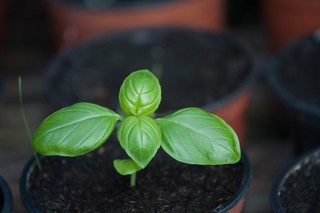How to grow basil indoors (beginner-friendly)

Sweet basil is a favorite for many, known for its rich aroma and tasty flavor. It’s the star in dishes like pesto, salads, and pasta sauces. With its vibrant green leaves, it’s no wonder it’s a top pick in the kitchen. Growing it at home isn’t hard, and with this guide, you’ll have fresh basil at your fingertips all year round.
To grow sweet basil indoors, you need a 6-inch pot with drainage holes, a room temperature of at least 70°F, and 6–8 hours of direct sunlight per day. Water when the soil’s top layer feels dry.
Why grow basil indoors?
It’s easier to grow sweet basil indoors than outdoors because you have more control over things like temperature and bugs. Outside, the weather and pests can be a wild card.

Join our email club—get printable info cards free!
Sign up to receive our newsletter and get access to 10 printable plant info cards from our e-book for free. Also receive:
- $4 discount code for our Guide to Herbs e-book
- Semi-weekly plant inspiration & bite-size tips and tricks
Getting started
Before embarking on the growth journey, ensure you have the essentials:
- Containers: Opt for a 6-inch pot with good drainage when starting.
- Soil: Light potting soil or coconut coir will ensure the right blend of aeration and moisture retention.
- Seeds or cuttings: Start with sweet basil seeds or take a cutting from an established plant.
- Light: A place with abundant sunlight or artificial grow lights is ideal. Basil requires at least 6 hours of light daily.

Containers
A single plant can comfortably grow in a 6-inch pot; if you want multiple plants, a 12-inch container can hold three. Make certain your chosen container has drainage holes.
We’ve experimented with numerous clay pots, and we recommend ones with mesh pads which keep the soil from exiting through the drainage hole. This particular one is 6 inches and comes as a four pack.
For more on choosing the right pot check out our complete pot selection guide.

Soil
Commercial soil mixes and coconut coir are both excellent for plant growth. They’re light and keep plants happy with the right amount of moisture. We’re big fans of Fox Farm potting soil, especially for plants in containers. Grab yours from Amazon here.
Want to become a soil pro? Dive into our article on the best soils for indoor herbs.
Seeds or cuttings
Starting sweet basil is straightforward and there are two main ways to go about it: seeds and cuttings.
Seeds: These are readily available at local gardening centers or online stores. Simply plant them in soil, provide the right conditions, and they’ll sprout into young basil plants.
Cuttings: If you know someone with a basil plant, you can take a healthy stem, let it root in water, and then transfer it to soil. It’s a direct way to get a plant that’s a clone of the original.
Both methods are effective and can lead to a thriving basil plant in your home. Choose the one that best fits your convenience.
Starting sweet basil from seeds
- Preparation: Begin by choosing high-quality sweet basil seeds from your local garden center or online.
- Planting: Fill a container with potting soil, leaving about an inch from the top. Evenly spread your seeds over the soil, then lightly cover them with a thin layer of more soil.
- Watering: Gently mist the soil using a spray bottle to keep it moist, but not soggy.
- Germination: Place the container in a warm location. The seeds will typically sprout in 5-10 days. Once they have two sets of true leaves, you can consider transplanting if they look crowded.
Starting sweet basil from plant cuttings
- Choosing a stem: From an established sweet basil plant, select a healthy-looking stem that’s about 4-6 inches long.
- Making the cut: With sharp scissors, snip off the chosen stem. Remove leaves from the bottom 2 inches of the stem.
- Rooting in water: Put the cut stem in a glass of water, making sure the stripped section is submerged. In a week or two, tiny roots will start to appear.
- Planting: Once the roots are around 2 inches long, transfer the cutting to a pot with soil. Water it lightly.
Growing sweet basil as microgreens
- Selecting a tray: Use a shallow tray, typically 1-2 inches deep.
- Preparing the tray: Fill it with a thin layer of potting soil or a specialized microgreens mix.
- Sowing the seeds: Spread sweet basil seeds densely across the tray.
- Light watering: Mist the seeds with water, ensuring the soil is moist but not waterlogged.
- Growing: Place the tray in a location with indirect sunlight. The seeds will sprout and start growing quickly.
- Harvesting: In 2-3 weeks, when they’re about 2 inches tall, use scissors to snip the microgreens just above the soil level. Enjoy them fresh in salads, sandwiches, and other dishes.
How to care for your sweet basil plant
Growing sweet basil indoors has its perks—no pests and consistent conditions. But to make the most of it, here’s how to care for your indoor basil plants.
Temperature needs
These plants thrive in warmth. A consistent room temperature of at least 70-75°F (21-24°C) is sufficient, but warmer temperatures (up to 82°F or 28°C) will allow your basil to grow bigger and more flavorful.[1] Keep your basil away from chilly drafts at all costs.
Light requirements
Sweet basil craves light. Offer it abundant, direct sunlight. If natural light isn’t possible all day, a grow light can fill the gap. Provide at least 6-8 hours of sunlight daily.
If your goal is to expose your plant to real sunglight, stick to windows that face southward or westward. South-facing windows provide the most sunlight in homes, whereas windows facing westwardly receive a long period of direct sunlight but often miss the hottest, most intense part of the day—which is great if you live near the equator.
Looking for an appropriate grow light? Basil responds well to either fluorescent or high-intensity discharge (HID) growing lights.
Watering guidelines
Your sweet basil enjoys a consistently moist soil environment. It’s a good idea to touch the soil every few days to check its moisture level.
If the top inch feels dry, give it a drink. But remember, overwatering can be harmful. Good drainage is key, and yellowing leaves can hint that you’re watering too much.
Spacing instructions
Thin plants when they reach a couple of inches tall. Put the single, best-looking plant into a 6-inch container. Transplant the next three best-looking seedlings into a 12-inch container spacing them as far apart as possible. Sweet basil yields the most plentiful harvests when plants are spaced 20 cm (~8 inches) apart.[2]
Fertilization recommendations
Feeding your indoor basil is key to its growth. A balanced, water-soluble fertilizer works wonders; just follow the package’s directions. Typically, once every two weeks is a good rhythm. If you notice yellowing leaves, this might be a sign your basil needs a nutrient boost. Remember, over-fertilizing can harm your plant, so moderation is key.
Pruning guidelines
Giving your sweet basil a little trim helps it grow thicker and bushier. By just snipping the top ends, you’ll encourage more leaves to sprout.
You might spot some flowers from time to time. They’re pretty, but if you pinch them off, the plant will put more effort into growing those tasty leaves you love.

Harvesting guidelines
When your basil looks full, it’s time to harvest. Regularly snipping off some leaves or stems prompts the plant to sprout anew, giving you a lush, full appearance. Just like many indoor herbs, harvesting basil is a breeze.
For the finest results:
- Aim to harvest in the morning. This is when the plant’s essential oils, which give it that rich flavor, are at their peak.
- Use clean, sharp scissors or even your nails to snip stems just above where two leaves join, ensuring you don’t leave any stem stubs.
- Every now and then, pinch off the tips of branches. This nudges your basil to spread out rather than shoot up, filling out its form.
- If your basil seems a bit too wild or tall, don’t hesitate to trim it down a bit. Starting from the top, work your way down, but always ensure you’re not taking off more than two-thirds of the plant in one go.
- Remember: those fragrant leaves are best when picked before the plant blooms. If your basil starts flowering, nip those blooms in the bud and hold off on harvesting for a couple of days.
Once you’ve got your fresh basil, you can use it immediately or store it for later. Drying, freezing, or soaking it in oil are all solid preservation methods.
Common challenges and solutions
- Leggy plants: This indicates inadequate lighting. Shift your basil closer to the light or invest in additional grow lights.
- Yellowing leaves: This might result from overwatering. Let the topsoil dry before the next watering session.
- Pests: Aphids or whiteflies can sometimes become problematic. Address them with insecticidal soap or neem oil.
Differences between sweet basil and other basil varieties in growth
Basil comes in various types, each beloved by gardeners and cooks. Sweet basil is distinct not only for its flavor and look but also its growth habits. Here’s a comparison of sweet basil’s growth to other basil varieties:
1. Temperature tolerance
Sweet basil is sensitive to excessive heat, unlike Thai basil which can handle higher temperatures.
2. Growth rate
Sweet basil grows faster than many other basil types.
3. Flowering times
Sweet basil might bloom sooner than some other basil variants.
4. Pest susceptibility
Sweet basil can be more susceptible to pests than varieties like lemon basil.

Join our email club—get printable info cards free!
Sign up to receive our newsletter and get access to 10 printable plant info cards from our e-book for free. Also receive:
- $4 discount code for our Guide to Herbs e-book
- Semi-weekly plant inspiration & bite-size tips and tricks
FAQ
Does basil grow well indoors?
Absolutely! With the right care, basil thrives indoors.
Do basil plants need direct sunlight?
Basil enjoys sunlight, and needs about 6–8 hours of it every day for optimal growth.
What is the ideal temperature for basil?
Basil loves warmth. Aim for a temperature range between 70-82°F (21-28°C).
What is the best potting mix for sweet basil?
A light, well-draining potting mix works wonders. Mixes designed for container cultivation, like Fox Farm, are particularly good.
Is there a best time of year to start a basil plant indoors?
You can start basil anytime indoors, but starting in the spring or early summer ensures it gets all the light and warmth it needs.
How often does basil need to be fertilized?
Feed your basil once every 4-6 weeks with a balanced liquid fertilizer, especially during its growing months.
How often does basil need to be watered?
Water basil when the top layer of soil feels dry to the touch, but ensure the potting mix remains slightly damp and not soggy.
Mortensen, L. M. (2014). The Effect of Air Temperature on Growth of Eight Herb Species. American Journal of Plant Sciences, 5, 1542-1546. doi: ajps.2014.511168 ↩︎
Davis, J. M. (1993). In-Row Plant Spacing and Yields of Fresh-Market Basil. Journal of Herbs, Spices & Medicinal Plants, 2(1), 35-43. doi: 10.1300/J044v02n01_05 ↩︎
